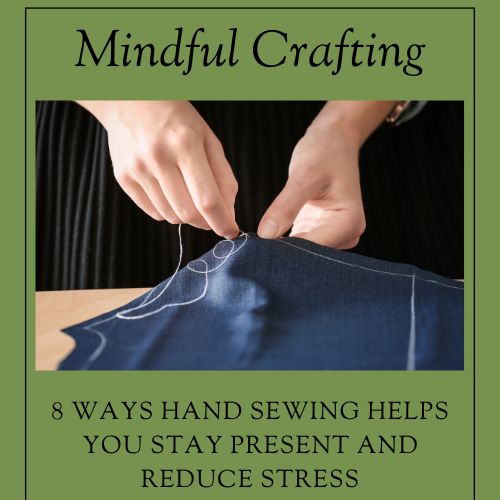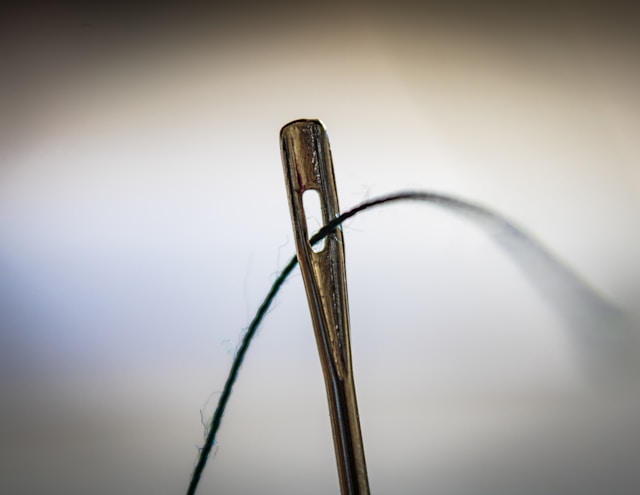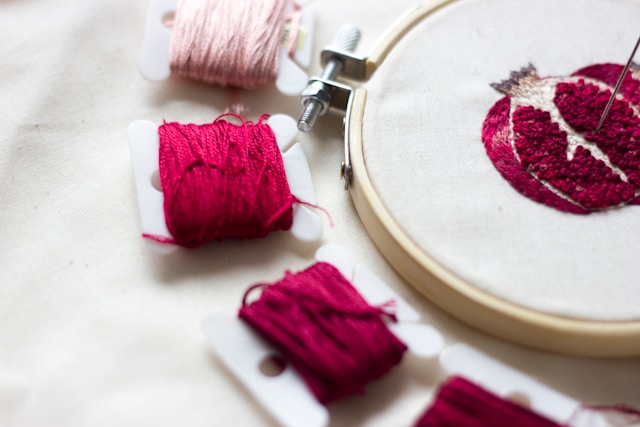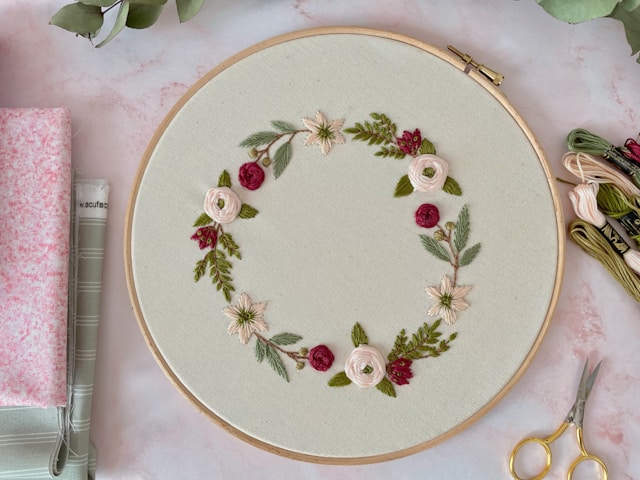There’s something uniquely calming about hand sewing—the quiet rhythm of the needle moving through fabric, the soft tension of thread, the way time slows down as stitches come together. Unlike machine sewing, which focuses on speed and precision, hand sewing is an intimate, tactile experience that naturally encourages mindfulness and presence.
Beyond its practicality, hand sewing has long been used as a therapeutic tool—helping to ease stress, settle the mind, and bring a sense of peace to those who practice it. Whether you’re sewing for function, creativity, or relaxation, this craft offers a unique way to stay present and manage stress through movement, texture, and ritual.
8 Ways Hand Sewing Helps You Stay Present and Reduce Stress
Here are eight ways hand sewing can help you stay grounded, focused, and emotionally balanced—along with a simple exercise to help you experience these benefits firsthand.

1. Creates a Slow, Intentional Rhythm That Anchors the Mind
Hand sewing naturally forces you to slow down—each stitch requires patience, precision, and attention to detail. Unlike modern life, which is filled with fast-moving tasks and distractions, sewing follows a gentle, predictable rhythm that helps anchor the mind in the present moment.
Each movement—threading the needle, pulling it through, knotting the thread—becomes a micro-meditation, training your brain to be fully engaged in the process. This slow, methodical pace makes it easier to quiet racing thoughts and cultivate inner calm.
2. Engages the Senses for a Grounding Experience
One of the reasons hand sewing is so effective at reducing stress is because it engages multiple senses at once, offering a tactile and visual experience that helps ground you in the moment.
- Touch – The texture of the fabric, the feel of the needle, the pull of the thread
- Sight – Watching each stitch take shape, seeing patterns and colors come together
- Sound – The quiet slide of thread through fabric, the soft rustling of materials
This sensory immersion provides a natural antidote to anxiety, helping to pull attention away from stressful thoughts and back into the physical experience of creating.
3. Activates the Parasympathetic Nervous System (Your Body’s Relaxation Response)
The repetitive motion of hand sewing has a direct impact on the nervous system. The steady, focused stitching signals the parasympathetic nervous system—which is responsible for relaxation and restoration—to activate.
✔ Slows heart rate and lowers blood pressure
✔ Reduces levels of cortisol (the stress hormone)
✔ Helps shift the body from a state of tension to a state of calm
Sewing, much like knitting or crochet, provides a repetitive, structured motion that tells the body it is safe, helping to counteract the stress response.
4. Provides a Meditative Alternative for Those Who Struggle with Stillness
Traditional meditation isn’t for everyone—many people find it difficult to sit still and quiet the mind. Hand sewing offers a moving meditation, giving your hands something to do while allowing the mind to settle naturally.
Instead of trying to force yourself to be still, you can focus on each stitch, the feel of the needle, and the motion of pulling thread through fabric. This provides all the benefits of mindfulness without the frustration that sometimes comes with seated meditation.
5. Encourages Deep Breathing and Nervous System Regulation
Have you ever noticed how your breathing slows when you’re deep in a creative task? Hand sewing has a natural pacing that encourages deeper, more mindful breathing.
Try this:
- Inhale as you guide the needle through the fabric.
- Exhale as you pull the thread through.
- Pause before beginning the next stitch.
This rhythmic breath-stitch synchronization helps regulate your nervous system, calming anxiety and promoting relaxation.
6. Provides a Gentle, Focused Distraction from Overthinking
Anxiety often comes from rumination—replaying past events or worrying about the future. Hand sewing keeps your hands busy and your mind gently occupied, breaking the cycle of repetitive negative thoughts.
Instead of spiraling into stress, sewing redirects attention toward something productive, creative, and tangible. It offers just enough engagement to occupy the mind, without being overwhelming.
7. Encourages a Connection to Tradition and Meaningful Making
There’s something deeply grounding about engaging in a craft that has been practiced for centuries. Hand sewing connects us to generations of makers who stitched before us—whether for necessity, beauty, or storytelling.
Knowing that your hands are part of this long lineage of makers can create a sense of rootedness and belonging, offering emotional comfort and a reminder that creativity is timeless.
8. Turns Time Into Something Tangible
One of the most rewarding aspects of hand sewing is that it makes time visible. In today’s world, where time feels like it vanishes into screens and distractions, sewing provides a physical record of moments spent mindfully.
Each stitch represents a moment of presence—a decision made, a thought processed, a breath taken. Over time, sewing can become a practice of marking moments in fabric, a slow and steady record of life as it unfolds.
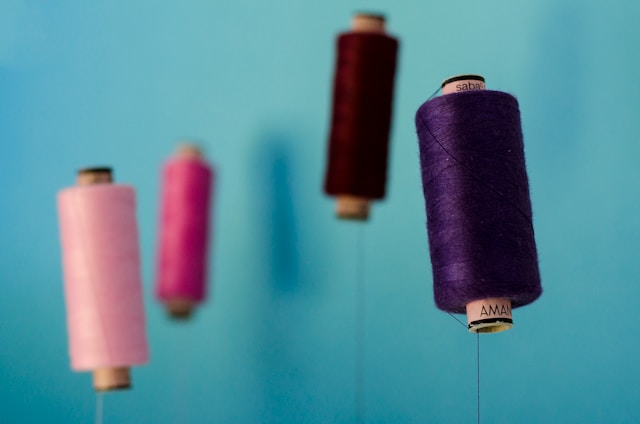
Mindful Stitching Exercise: The One-Stitch Pause
If you want to experience hand sewing as a mindfulness tool, try this One-Stitch Pause exercise:
- Gather a small piece of fabric and a needle with thread. Choose colors that feel calming to you.
- Before making your first stitch, close your eyes and take a deep breath. Set an intention for your sewing session—whether it’s relaxation, gratitude, or simple presence.
- Make one stitch, then pause. Instead of immediately making another stitch, take a moment to observe your breath, the feel of the fabric, and the tension of the thread.
- Continue stitching slowly, pausing between each stitch. Let your mind settle into the rhythm, allowing the pauses to feel as valuable as the stitching itself.
Even just five minutes of this practice can help reset your mind and body, bringing a sense of calm and clarity.
Next Steps: Using Hand Sewing as a Mindfulness Practice
✔ Choose one aspect of hand sewing to focus on more intentionally. Is it the rhythm? The texture? The history?
✔ Experiment with slow stitching. Take your time, work with no rush, and appreciate the process.
✔ Try hand sewing as a meditative practice. Stitch in silence, sync with breath, or stitch with a specific intention in mind.
If you’re looking for ways to bring mindfulness and emotional well-being into your creative practice, the Craft to Heal year-long workshop series explores how fiber arts can support relaxation, focus, and self-care.
Explore this in more depth by joining my Craft to Heal workshop.
